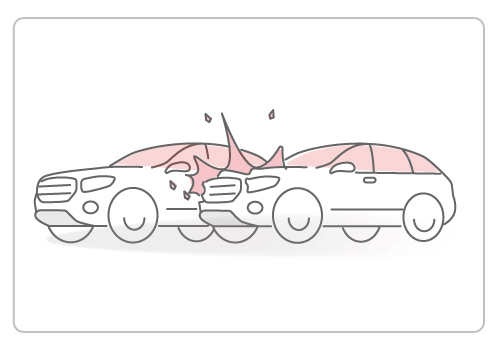
Written by Kayla Jane Barrie Updated on Mar 10, 2025 4 mins read

Though they may not sound serious, side-swipe accidents can have very serious consequences due to the direction of the impact. Side-swipe collisions can result in minor or significant damage, especially at high speeds.
In this blog, we define a sideswipe accident, provide some practical examples, and discuss how sideswipes may increase your Ontario car insurance.
A sideswipe accident happens when two vehicles travelling in the same direction collide from the side. It occurs when one vehicle veers out of its lane and into the adjacent lane.. In rarer cases, it can involve near-miss head-on collisions between cars travelling in opposite directions due to veering out of their lanes.
The force comes from the side, making it hard for drivers to regain control. This can lead to spinning out, veering into another lane, hitting objects, other vehicles, or flipping over, often resulting in rollovers, fatal crashes, or head-on collisions.
Most sideswipe accidents occur on highways between cars travelling in the same direction at high speeds, resulting in severe damage to vehicles and bodily harm to drivers and passengers.
Here are a couple of sample scenarios to give a visual of sideswipe accidents.
Highway lane change
While driving on the highway, Jane attempted to change lanes to overtake a slower vehicle but accidentally side-swiped John's car. They both pulled over to assess the damage and exchange insurance information.
Merging on a city street
Mark and Lisa approach a lane merge in a busy city. Mark accelerates to get ahead of Lisa, but runs out of space to merge, causing a sideswipe. Both vehicles stop, partially blocking the lane, and the drivers discuss the situation.
Parking lot sideswipe
Sarah is backing out of a parking space in a busy grocery store lot when she accidentally backs into Michael's car, driving down the aisle, looking for a spot. Both drivers stop, assess the damage, and exchange details to file claims.
Some common causes of sideswipe car accidents include distracted driving, improper lane changes, and driving too closely to other vehicles. It's important to be aware of these factors to prevent such accidents in the future.
In a sideswipe crash, the driver who failed to stay in their lane or violated traffic laws is usually considered at-fault. However, insurers will refer to the Ontario Fault Determination Rules to determine who caused the accident.
Determining fault in sideswipe accidents is a priority for insurance companies. Typically, the driver who failed to check their blind spot or did not signal their intention to change lanes is considered at-fault. However, there are cases where both drivers may share fault if they move towards the same lane simultaneously.
Insurance companies consider fault-based accidents as a risk factor, which can result in adjustments to your rates.
If you have collision coverage, your insurance will cover the cost of repairs to your vehicle after you pay the deductible. However, if the other driver is at-fault, their third-party liability insurance should cover your repair costs. If the other driver is uninsured or underinsured, your uninsured motorist coverage can help cover the damages.
Sideswipe accidents, often seen as minor, can have significant consequences for drivers and their insurance. Understanding their impact and taking preventive measures can reduce risks. Safe driving habits, vehicle maintenance, and awareness of surroundings can help avoid these accidents. Drive responsibly and always ensure your car insurance is up to date.
Read our insurance blog to get helpful tips, information and news.
Get the facts on Toronto's auto theft problem. We break down the data, reveal the most-stolen vehicles (including the Honda CR-V and Lexus RX 350), and show which neighbourhoods are most affected.
Dive into the world of auto theft with our blog on the most stolen cars in Canada. See the most stolen cars across Canada, including provincial lists for Ontario and Quebec, and learn how high-risk models can affect your car insurance premiums.
Drive safe this winter! Check out these tips for driving in snowy and icy conditions in Ontario. Get other helpful info and FAQs on winter driving.
Drive safer this winter. Learn how the right set of winter tires drastically reduces stopping distance and risk on ice and snow. Get expert tips from your trusted insurance provider.